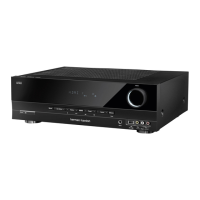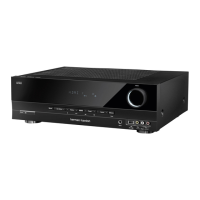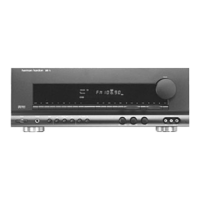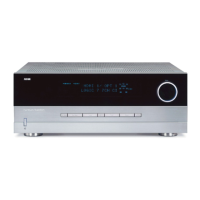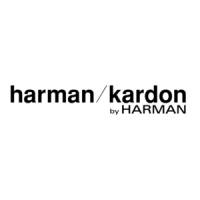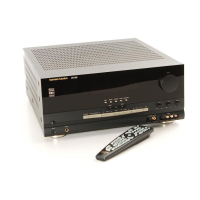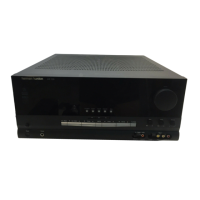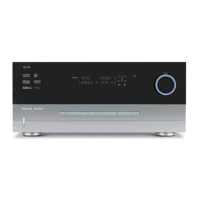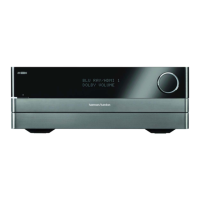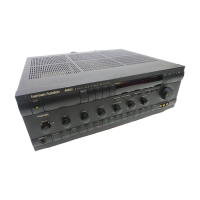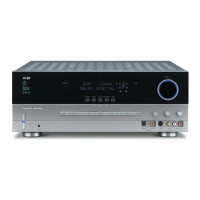OPERATION 29
Operation
However to create wider, enveloping sound field
environments and more defined pans and fly-
overs with all analog stereo and surround record-
ings select Harman Kardon’s exclusive Logic 7
mode, that creates a stereophonic left and right
rear signal, just as recorded in real life (e.g.
sound being recorded from left rear side will be
heard from that side only) for a dramatic
improvement in comparison to Dolby Pro Logic.
NOTE: Once a program has been encoded with
matrix surround information, it retains the sur-
round information as long as the program is
broadcast in stereo. Thus, movies with surround
sound may be decoded via any of the analog sur-
round modes such as Pro Logic or Logic 7, when
they are broadcast via conventional TV stations,
cable, pay TV and satellite transmission. In addi-
tion, a growing number of made-for-television
programs, sports broadcasts, radio dramas and
music CDs are also recorded in surround sound.
You may view a list of these programs at the Dolby
Laboratories Web site at www.dolby.com.
When a program is not listed as carrying inten-
tional surround information, you may find that the
Pro Logic, Dolby 3 Stereo or Logic 7 modes often
deliver enveloping surround presentations through
the use of the natural surround information pres-
ent in all stereo recordings. However, for pure
stereo programs without any surround information
(e.g. some old ”extreme” stereo recordings) and
for mono programs, we suggest that you try the
Theater or Hall modes.And when you use only
two front channel speakers you should select
Harman’s patented VMAx mode, delivering a virtu-
ally three dimensional sound space with two
speakers only.
Surround modes are selected using either the
front panel controls or the remote. To select a
surround mode from the front panel, press the
Surround Mode Selector
7
to scroll through
the list of available modes. To select a surround
mode using the remote, press the Surround
Mode Selector
, and then press the
⁄
/
¤
buttons
6
to change the mode. As you press
the buttons, the Surround mode name will
appear in the Main Information Display
W
,
and an individual mode indicator will also light
up
B D G H I J K
. As the surround
modes change, a green LED will light next to the
current mode in the Surround Mode
Indicators list
ı
on the front panel.
Note that the Dolby Digital or DTS modes may
only be selected when a digital input is in use. In
addition, when a digital source is present, the
AVR 7000 will automatically select and switch to
the correct mode (Dolby Digital or DTS), regard-
less of the mode that has been previously select-
ed. For more information on selecting digital
sources, see the following section of this manual.
To listen to a program in traditional two channel
stereo, using the front left and front right speak-
ers only (plus the subwoofer if installed and con-
figured), follow the instructions shown above for
using the remote until SURR OFF appears
in the Main Information Display
W
.
Digital Audio Playback
Digital audio is a major advancement over past
systems such as Dolby Pro Logic. It delivers five dis-
crete channels: left front, center, right front, left sur-
round and right surround. Each channel reproduces
full frequency range (20Hz to 20kHz) and offers
dramatically improved dynamic range and signifi-
cant improvements to signal-to-noise ratios. In
addition, digital systems have the capability to
deliver an additional channel that is specifically
devoted to low frequency information.This is the
“.1” channel referred to when you see these sys-
tems descibed as “5.1”. The bass channel is sepa-
rate from the other channels, but since it is inten-
tionally bandwidth limited, sound designers have
given it that unique designation.
Dolby Digital Dolby Digital (originally known as
AC-3
®
) is available on DVD, and specially encoded
LD discs and satellite broadcasts and is a part of
the coming high definition television (HDTV) sys-
tem.
Note that an optional, external RF demodulator
is required to use the AVR 7000 to listen to the
Dolby Digital sound tracks available on laser
discs. Connect the RF output of the LD player to
the demodulator and then connect the digital
output of the demodulator to the Optical or
Coaxial inputs
°·
of the AVR 7000. No
demodulator is required for use with DVD players
or DTS-encoded laser discs.
DTS
DTS is another digital audio system that is capa-
ble of delivering 5.1 audio. Although both DTS
and Dolby Digital are digital, they use different
methods of encoding the signals, and thus they
require different decoding circuits to convert the
digital signals back to analog.
DTS-encoded sound tracks are available on select
DVD and LD discs, as well as on special audio-
only DTS CDs. You may use any LD, DVD or CD
player equipped with a digital output to play
DTS-encoded special audio-only CDs with the
AVR 7000, but DTS-LDs can be played on LD
players and DTS-DVDs on DVD players only. All
that is required is to connect the player’s output
to either the Optical or Coaxial input on the
rear panel
°·
.
In order to listen to DVDs encoded with DTS
sound tracks, the DVD player must be compatible
with the DTS signal as indicated by a DTS logo
on the player’s front panel. Note that early DVD
players may not be able to play DTS- encoded
DVDs. This does not indicate a problem with the
AVR 7000, as some players cannot pass the DTS
signal through to the digital outputs. If you are in
doubt as to the capability of your DVD player to
handle DTS DVDs, consult the player’s owner’s
manual.
PCM Audio Playback
PCM (Pulse Code Modulation) is the non- com-
pressed digital audio system used for compact
discs, Non-Dolby Digital/DTS Laserdiscs and some
special PCM encoded DVDs. The digital circuits in
the AVR 7000 are capable of high quality digital-
to-analog decoding, and they may be connected
directly to the digital audio output of your
CD/DVD or LD player (LD only for PCM or DTS
programs, for Dolby Digital laser discs an RF
adapter is needed, see above).
Connections may be made to either the Optical
or Coaxial inputs
°·
on the rear panel.
To listen to a PCM digital source, first select the
input for the desired source (e.g., CD) to feed its
video signal (if any) to the TV monitor and to
provide its analog audio signal for recording.
Next press the Digital Select button
A
and then use the
⁄
/
¤
buttons
6
on the
remote, or the Selector buttons
5
on the front
panel, until the desired choice appears in the
Main Information Display
W
, then press the
Set button
(
8
to confirm the choice.
When a PCM source is playing, the PCM indica-
tor
A
will light. During PCM playback you may
select any surround mode except Dolby Digital or
DTS. When an HDCD encoded disc is being
played (see below) and the CD player is connect-
ed to the AVR 7000 via a digital connection,
select Surround Off as the Surround mode to
enjoy the benefits of the HDCD process.
Playback from PCM sources may also benefit
from the Logic 7. When playing back a surround-
encoded PCM source, such as an LD or surround-
encoded CD, use the Logic 7 C or Cinema mode.
When playing true stereo recordings, use the
Logic 7 M or Music mode for a wider sound
stage and increased rear channel ambience.
HDCD
HDCD, which stands for High Definition
Compatible Digital
®
, is a sophisticated process
that enables the AVR 7000 to deliver outstanding
digital-to-analog decoding of PCM signals from
any DVD or CD player, connected to a digital
input on the AVR 7000, no matter what type of
CD or DVD is played and even when normal,
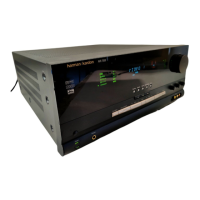
